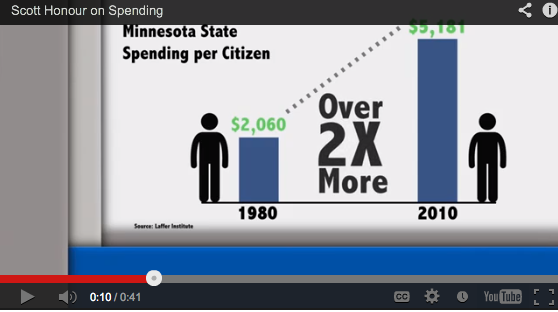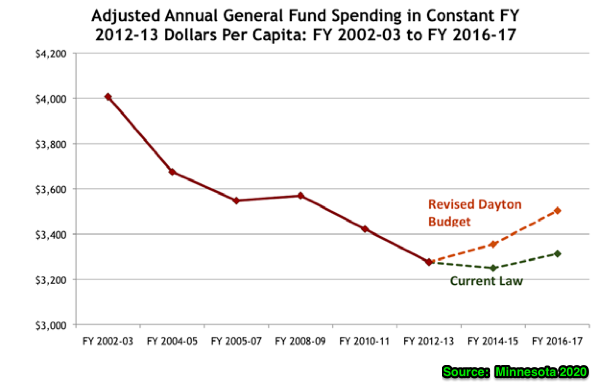Minnesota GOP gubernatorial candidate Scott Honour has a surname that sounds as if it was fabricated by a team of political consultants. What, “Bob Dignity” wasn’t available to run for governor?
I don’t know a lot about Mr. Honour’s pre-political life, but from what he has published on his website biography, he sounds like a pleasant chap and a capable business person.
But so far, his performance since becoming a politician does not live up to the expectations set by his surname.
Mr. Honour has been busy making the case that Minnesota state government spending is out-of-control. For instance, this campaign video claims:

“Did you know that our state is spending over twice as much per citizen as when I graduated from high school in 1984? It sure doesn’t feel like we’re getting twice as much value for our money.”
That’s a potent political statement. But is it an honorable statement? A truly honorable leader would acknowledge that the median household income when Mr. Honour graduated from high school in 1984 was $22,415.00, while in February 2013 median household income had grown to $51,404, more than twice as high as it was in 1984.
As a successful businessperson, Mr. Honour surely understands that as household incomes have more than doubled between 1984 and 2013, the cost of just about everything else, including the major things government has to purchase – medical care, medical devices, pharmaceuticals, energy, asphalt, private and public sarlaries, technology, real estate, construction materials, etc. — have also gotten dramatically more expensive. He is a bright and experienced enough businessperson to understand that economic reality, but he is not honorable enough to publicly acknowledge it.
So what’s the truth about state government spending in Minnesota. A thoughtful and thorough Minnesota 2020 analysis recently found:
Adjusted for inflation, accounting shifts, state takeovers, and the tobacco bond sale, Minnesota is spending about $5.2 billion less (in 2012-13 dollars) than it was a decade ago. That’s roughly $730 less per capita, or an 18 percent decline in state expenditures.
Claims of rapid state spending growth are based on comparisons that fail to account for inflation, population, school funding shifts, and other one-time events that distort spending over time.
If legislature implements Governor Dayton’s current budget plan, by FY 2016-17 Minnesota’s adjusted per capita spending would still be $500 less than it was a decade ago (FY 2002-03).

Continue reading →
 The St. Paul Pioneer Press reported today that Republican gubernatorial candidates have been having daily one up-manship contests over who can have the earliest and nastiest news conference railing about a Dayton-related headline of the day.
The St. Paul Pioneer Press reported today that Republican gubernatorial candidates have been having daily one up-manship contests over who can have the earliest and nastiest news conference railing about a Dayton-related headline of the day.

